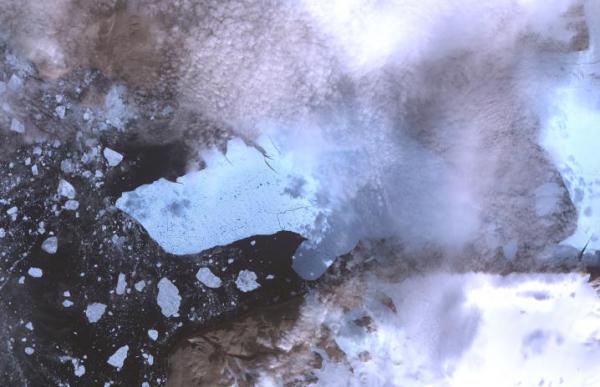New Image Reveals Massive Greenland Iceberg


NASA has released a new image today of the chunk of ice four times the size of Manhattan that calved from Greenland's Petermann Glacier on Aug. 5.
The picture was taken by NASA's ASTER instrument on the Terra satellite on Aug. 12 and shows the enormous chunk of ice , about 97 square miles (251 square kilometers) in size, which broke off the glacier located along the northwestern coast of Greenland.
Petermann Glacier is one of the two largest remaining glaciers in Greenland that terminate in floating shelves. The glacier connects the great Greenland ice sheet directly with the ocean.
When the iceberg broke off, the Petermann Glacier lost about one-quarter of its 43-mile- (70-kilometer-) long floating ice shelf, according to researchers at the University of Delaware.
The recently calved iceberg is the largest to form in the Arctic in 50 years.
Icebergs calving off the Petermann Glacier are not unusual. Petermann Glacier's floating ice tongue is the Northern Hemisphere's largest, and it has occasionally calved large icebergs.
Scientists are monitoring the movement of the iceberg closely. If it moves out into the narrow Nares Strait, there is the potential it could interfere with or block the loss of Arctic sea ice out of the Arctic Ocean into Baffin Bay, a sea that connects the Arctic and Atlantic Oceans. The ice could also eventually pose a hazard to shipping.
Get the world’s most fascinating discoveries delivered straight to your inbox.
It covers an area of 30.7 by 19.5 miles (49.5 by 31.5 km) and is located at 81.1 degrees north latitude, 61.7 degrees west longitude, about 620 miles (1,000 km) south of the North Pole.
The last time such a massive ice island formed was in 1962 when Ward Hunt Ice Shelf calved a 230 square-mile (600 square-km) island, smaller pieces of which became lodged between real islands inside Nares Strait. Petermann Glacier spawned smaller ice islands in 2001 (34 square miles, or 88 square km) and 2008 (10 square miles, or 26 square km). In 2005, the Ayles Ice Shelf disintegrated and became an ice island (34 square miles) about 60 miles (97 km) to the west of Petermann Fjord.
In July, a chunk of ice the size of Manhattan fell off of Greenland's Jakobshavn Isbrae glacier .



